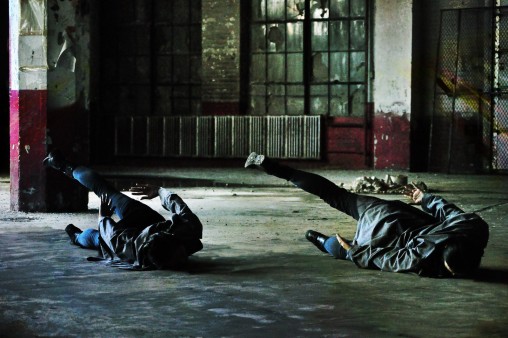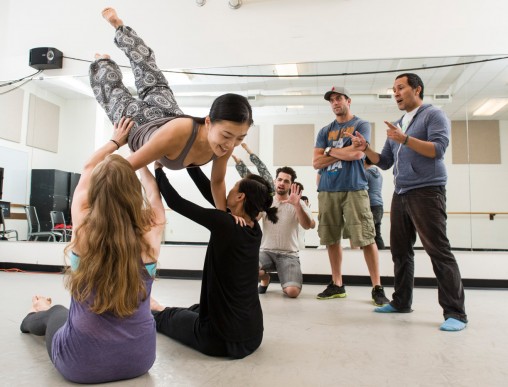
Wright State acting professor Jason Kaufman is turning a dance piece originally choreographed for the stage into a 30-minute film. Pictured is a scene from “Slippage.”
Wright State assistant professor of acting Jason Kaufman has always been interested in movement.
His training as an actor included a movement-based focus and many of his roles have required some level of movement.
Now Kaufman is taking movement in a dance piece originally choreographed for the stage and turning it into a 30-minute film.
“I love shooting dance on camera because the dance can become more intimate,” Kaufman said. “As a director I get to choose what part of the body and how it moves through the frame and what part of the body tells the story. It’s dialogue of the body rather than words.”
Kaufman, who teaches in the Department of Theatre, Dance and Motion Pictures, spent last week in downtown Dayton filming “Slippage” with choreographer Maurice Fraga, three dancers and a small crew.
“Slippage” is a dance for camera film, a style of filmmaking that tells a narrative story through choreography, camera placement and editing.
“How do we tell the story with the score or music for the film that will be original?” Kaufman said. “It was an interesting story that I thought could translate to a film. There is a strong narrative to it.”
Fraga, artistic director of the Ekilibre Dance Company and assistant professor of dance at Shenandoah University, spent about 10 years fine-tuning the choreography in “Slippage” which was performed on stage in 2014 in New York City.
He said he wants to make a film that will interest dance lovers and non-dance fans alike.
“There are no words so through the movement and through the cinematography we’re able to convey the story. So that anybody, even if you’re a dance fan or not, will be able to follow that story,” he said.

From right: choreographer Maurice Fraga, Wright State’s Jason Kaufman, Caleb Forsythe, one of the directors of photography, and dancers Ching-I Chang, Nico Li and Nancy Andrews rehearsing “Slippage” in the Creative Arts Center. (Photo by Erin Pence)
“Slippage” tells the story of a woman who attempts to exorcise an unforgiving memory that will not allow her to move forward. With the help of a friend, she confronts this memory directly in the deepest recess of her mind.
“This memory, in our piece, is represented by a woman. Like all memories they lurk inside us fighting not to be forgotten,” Kaufman said.
Nancy Andrews, one of the dancers, said she was excited to create something permanent on film.
“Usually when you film a dance in the audience, something is missing. The energy you feel, the exciting part, you can’t really capture that,” she said. “So this is the first time I’ve been able to see that is being captured.”
During the course of filming, Fraga, Kaufman and the dancers actually changed the story in “Slippage,” making the narrative stronger.
“It’s also made this piece clearer for me now,” Fraga said. “So the next time it gets done on stage there’s a through line that we have that wasn’t there, and I think that might help dancers go from A to C.”
To help capture the dancers’ movements, Kaufman mounted a camera on a Ronin, a three-axis gimbal worn by the camera operators. The Ronin allowed the operators to move the camera fluidly with the dancers as they moved. As a result, viewers will see images that appear to float and move smoothly.
This also presented Kaufman with a unique opportunity.
“His movements will be choreographed as much the dancers’ movements,” Kaufman said of the camera operator. “The camera becomes another dancer.”
Kaufman recruited students and alumni from Wright State’s film program to assist with the project as camera operators and lighting designers.
After Kaufman and Fraga met at Shenandoah they agreed to work together on a project.
“I really like Maurice’s work, I like the movement he creates, so I wanted to work with him,” Kaufman said.
Kaufman, who spent the summer playing Stanley in “A Streetcar Named Desire” in Cleveland, hopes to complete post-production work on the film by December and submit it to film festivals in 2016.

 Heavy metal learning
Heavy metal learning  State grants to bolster Wright State’s electric vehicle and advanced manufacturing training for students
State grants to bolster Wright State’s electric vehicle and advanced manufacturing training for students  Wright State partners with local universities, hospitals to expand mental health care for students
Wright State partners with local universities, hospitals to expand mental health care for students  Wright State students, first responders team up for Halloween event
Wright State students, first responders team up for Halloween event  Explore Wright State Day welcomes hundreds of future Raiders
Explore Wright State Day welcomes hundreds of future Raiders 